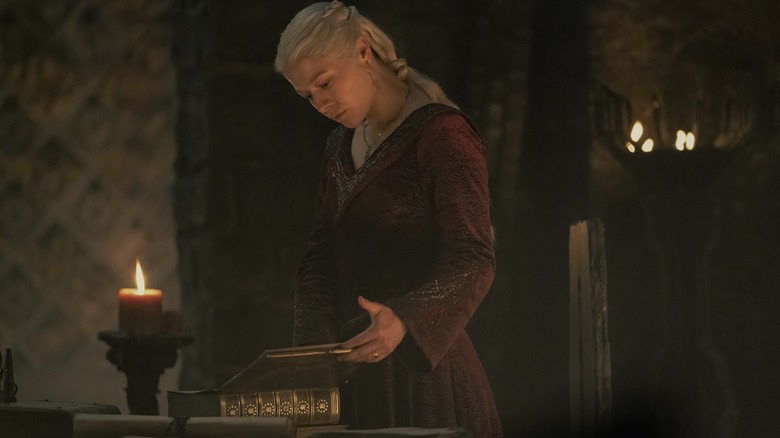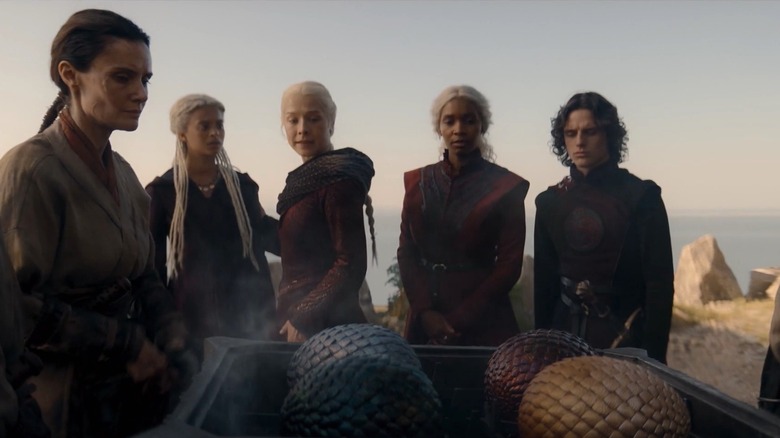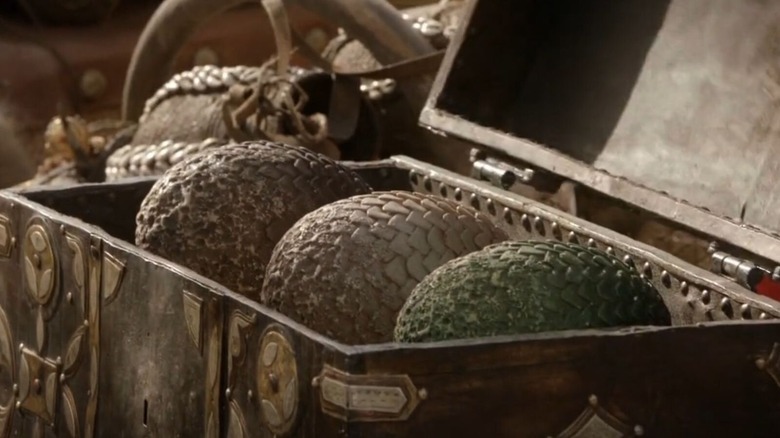House Of The Dragon Just Solved One Of The Biggest Game Of Thrones Mysteries
Winter is coming, and so are spoilers. This article discusses events from the latest episode of "House of the Dragon."
If the entirety of the debut season and the first two episodes of "House of the Dragon" season 2 didn't make it clear already, then there's little doubt anymore: War is coming to Westeros, a "hateful" one between kin and a "bloody" one between dragons (as Eve Best's Princess Rhaenys warns Emma D'Arcy's Queen Rhaenyra early on) all wrapped up in a single conflict. Book readers and fans who've paid an inordinate amount of attention to franchise lore know that this civil war will have lasting ramifications on the Seven Kingdoms centuries later, even during "Game of Thrones" — in fact, they're the only ones who may remember that the original show already "spoiled" the outcome of this prequel series, the events of which were documented by author George R.R. Martin in his "Fire & Blood" novel. But while fans wait for the arrival of epic action sequences to come, episode 3 may have just snuck in its biggest and most enduring connection to "Game of Thrones" yet.
Amid both Rhaenyra and Queen Alicent's (Olivia Cooke) best efforts to prevent wholesale bloodshed over a war for the Iron Throne, Rhaenyra makes a shrewd choice to help prepare for the worst — one that just paved the way for the events of "Game of Thrones" to unfold exactly the way they did. Still reeling from the assassination attempt at Dragonstone, the Queen opts to send her youngest children away from danger under the watchful eye of her cousin/stepdaughter Rhaena Targaryen (Phoebe Campbell). But coming along for the ride are a clutch of precious dragon eggs, three of which could very well end up as the same ones belonging to Daenerys Targaryen.
Did House of the Dragon snuck in a Game of Thrones origin story? (Update: Yes)
Update: In an interview with Mashable, director Geeta Vasant Patel confirmed that those eggs do indeed eventually belong to Daenerys. "Those are Daenerys' eggs," Patel said. "All of us who work on this show are big 'Game of Thrones' fans, so it was very exciting to shoot that scene." Our original article continues below.
Nobody expected "House of the Dragon" creator/showrunner Ryan Condal and his writing team to stop the show in its tracks and announce every time they decided to draw parallels between the original "Game of Thrones" — but, honestly, that's exactly what they might as well have done in episode 3. To help sooth Rhaena's understandable reluctance to babysit her young relatives on a thankless mission far away from the excitement of war, Rhaenyra sends along a quartet of dragon eggs as both a show of trust and a matter of pragmatism. Should Team Black be forced to abandon their island stronghold or even lose the war to Team Green, at least some hope for the future will be preserved by Rhaena through these dragon eggs. While their initial destination is the mountain fortress of the Eyrie, Rhaenyra instructs her young relative to take her children all the way over the Narrow Sea to the city of Pentos, where Rhaena lived with her parents Daemon (Matt Smith) and Laena (Nanna Blondell) in season 1.
As it turns out, this lines up perfectly with how Daenerys (Emilia Clarke) first receives her fateful dragon eggs back in season 1 of "Game of Thrones." While living as a refugee with her feckless brother Viserys (Harry Lloyd), they end up as guests of a wealthy magistrate in Pentos. When forced to marry the warrior Khal Drago (Jason Momoa), Dany's presented with a gift of three fossilized dragon eggs — all of which match up quite well with the colors of the eggs as seen in "House of the Dragon." These, of course, eventually hatch and provide Dany the means to eventually conquer Westeros. Those seeds may have just been planted, centuries earlier.
Fire & Blood suggests a different theory
As with any good theory, however, it's only fair to present the evidence against it. While this provides a very neat and straightforward connection between the Targaryen dynasty at the time of the Dance of the Dragons and their Targaryen descendent Daenerys 200 years later, it's worth pointing out that this would represent a major change from the show's source material. Not that "House of the Dragon" has been shy about adding or subtracting from "Fire & Blood" before, but this would mark a much more significant alteration of canon than most others.
Although the origins of Dany's three dragons Drogon, Viserion, and Rhaegal have never been confirmed in either series or book, one major hint in "Fire & Blood" suggests an alternate explanation. Many years before the events of "House of the Dragon," the novel lays out a curious subplot involving the theft of three dragon eggs. Early in the reign of the Old King Jaehaerys (the same one depicted by Michael Carter in the prologue of "House of the Dragon" season 1), a noblewoman named Elissa Farman made off with eggs laid by Dreamfyre, who would eventually become Queen Helaena's (Phia Saban) dragon. She fled to — where else — Pentos, though it's rumored that she sold those eggs in order to live out her dream as a legendary sailor/explorer on the high seas. Those eggs were never recovered, but conventional wisdom suggested that eggs taken away from their heated hatcheries would turn to stone ... which is exactly what happens with Dany's eggs.
So, which theory is the "correct" one? Frankly, both can be true for their respective mediums. That's the fun of being a fan!
New episodes of "House of the Dragon" premiere on HBO and Max every Sunday.


